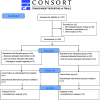Aprepitant plus palonosetron for the prevention of postoperative nausea and vomiting after breast cancer surgery: a double blind, randomized trial
- PMID: 32901672
- PMCID: PMC7454124
- DOI: 10.6061/clinics/2020/e1688
Aprepitant plus palonosetron for the prevention of postoperative nausea and vomiting after breast cancer surgery: a double blind, randomized trial
Abstract
Objectives: To evaluate the addition of a fourth antiemetic intervention in patients at high risk for postoperative nausea and vomiting (PONV).
Methods: High-risk patients (Apfel score 3 or 4) scheduled for unilateral mastectomy were randomly allocated in one of two groups, oral aprepitant (oral aprepitant 80 mg, intravenous dexamethasone 8 mg, and palonosetron 0.075 mg) and oral placebo (oral placebo, intravenous dexamethasone 4 mg, and palonosetron 0.075 mg). Patients and caregivers were blinded to the group assignments. The primary efficacy endpoints included the incidence of nausea and vomiting, and the secondary endpoints included use of rescue antiemetics during a 48-hour postoperative period. ClinicalTrials.gov: NCT02431286.
Results: One hundred patients were enrolled in this study and 91 were analyzed, 48 in group A and 43 in group P. No patient presented with nausea or vomiting in the first 2 hours after surgery. From the 2nd to the 6th hour, the incidence of PONV was 8.33% in group A and 9.30% in group P. In the first 24 hours, the incidence of PONV was 27.08% in the group A and 20.93% in group P. From the 24th to the 48th hour, the incidence of PONV was 8.33% in group A and 13.95% in group P. There were no statistically significant differences in PONV between groups.
Conclusion: The addition of aprepitant as a third antiemetic resulted in no significant reduction in the incidence of PONV in this population. However, the incidence of PONV was reduced in relation to the general population.
Conflict of interest statement
No potential conflict of interest was reported.
Similar articles
-
Palonosetron and aprepitant for the prevention of postoperative nausea and vomiting in patients indicated for laparoscopic gynaecologic surgery: a double-blind randomised trial.BMC Anesthesiol. 2014 Aug 10;14:68. doi: 10.1186/1471-2253-14-68. eCollection 2014. BMC Anesthesiol. 2014. PMID: 25165427 Free PMC article. Clinical Trial.
-
Aprepitant in combination with palonosetron for the prevention of postoperative nausea and vomiting in female patients using intravenous patient-controlled analgesia.Korean J Anesthesiol. 2018 Dec;71(6):440-446. doi: 10.4097/kja.d.18.00011. Epub 2018 May 30. Korean J Anesthesiol. 2018. PMID: 29843509 Free PMC article. Clinical Trial.
-
Comparison of efficacy between palonosetron-midazolam combination and palonosetron alone for prevention of postoperative nausea and vomiting in patients undergoing breast surgery and patient controlled analgesia: A prospective, randomized, double-blind study: A CONSORT-compliant study.Medicine (Baltimore). 2021 Jul 2;100(26):e26438. doi: 10.1097/MD.0000000000026438. Medicine (Baltimore). 2021. PMID: 34190167 Free PMC article. Clinical Trial.
-
Efficacy of palonosetron in postoperative nausea and vomiting (PONV)-a meta-analysis.J Clin Anesth. 2016 Nov;34:459-82. doi: 10.1016/j.jclinane.2016.05.018. Epub 2016 Jun 28. J Clin Anesth. 2016. PMID: 27687434 Review.
-
Recent advances, trends and economic considerations in the risk assessment, prevention and treatment of postoperative nausea and vomiting.Expert Opin Pharmacother. 2007 Dec;8(18):3217-35. doi: 10.1517/14656566.8.18.3217. Expert Opin Pharmacother. 2007. PMID: 18035965 Review.
Cited by
-
Assessing the impact of aprepitant and ondansetron on postoperative nausea and vomiting in orthognathic surgeries: a randomized controlled trial.BMC Anesthesiol. 2023 Dec 13;23(1):412. doi: 10.1186/s12871-023-02371-y. BMC Anesthesiol. 2023. PMID: 38093201 Free PMC article. Clinical Trial.
-
The efficacy of aprepitant for the prevention of postoperative nausea and vomiting: A meta-analysis.Medicine (Baltimore). 2023 Jul 21;102(29):e34385. doi: 10.1097/MD.0000000000034385. Medicine (Baltimore). 2023. PMID: 37478247 Free PMC article.
-
Comparison of aprepitant versus ondansetron for prevention of postoperative nausea and vomiting: A systematic review and meta-analysis with trial sequential analysis.Indian J Anaesth. 2024 Sep;68(9):762-775. doi: 10.4103/ija.ija_106_24. Epub 2024 Aug 16. Indian J Anaesth. 2024. PMID: 39386410 Free PMC article.
-
Effect of Palonosetron on Physical Symptoms of Surgical Patients: A Systematic Review and Meta-Analysis.Comput Math Methods Med. 2022 Mar 27;2022:7474053. doi: 10.1155/2022/7474053. eCollection 2022. Comput Math Methods Med. 2022. PMID: 35387223 Free PMC article.
-
Olanzapine as a prophylactic antiemetic for preventing postoperative nausea and vomiting after general anesthesia: A systematic review and meta-analysis.Clinics (Sao Paulo). 2024 Mar 20;79:100345. doi: 10.1016/j.clinsp.2024.100345. eCollection 2024. Clinics (Sao Paulo). 2024. PMID: 38513297 Free PMC article.
References
Publication types
MeSH terms
Substances
Associated data
LinkOut - more resources
Full Text Sources
Medical


